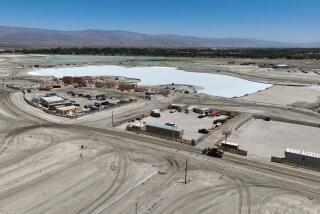Resort’s Mooring Proposal Makes Waves
- Share via
The developer of a five-star resort at Treasure Island in Laguna Beach is planning to build an offshore mooring area to park a 50-foot pleasure craft--despite possible clashes with city ordinances and concerns about a fragile marine reserve nearby.
Meanwhile, developer Athens Group sent the city a $9-million estimate for the city’s portion of a bluff-top park and other public amenities at the picturesque South Laguna site--millions more than the city anticipated.
“This project is out of control,” said Michael Beanan, vice president of the South Laguna Civic Assn.
The $150-million project, dubbed “The Laguna Beach Colony,” includes a 275-room resort, 17 homes, 14 condominiums and nearly 15 acres of open space on a 30-acre site of bluffs, sandy beach and rocky coves.
The Phoenix-based developer has submitted an application to the California Coastal Commission to install a concrete mooring and buoy system 750 feet offshore, past the shore area’s marine reserve. The commission may hear the matter at its November meeting in Valencia. The craft would be kept by the resort for use by guests.
Several attempts to reach officials with the Athens Group were unsuccessful Tuesday.
Details of the proposal were unavailable, but many environmentalists questioned the craft’s proximity to the reserve and how people would be transported from land, over the reserve, to the boat. The 4-acre marine area has been designated a reserve by the city and has been nominated for state status.
City officials point out that besides facing possible problems with the marine reserve, the developers would also be barred by city ordinances from landing or launching motorboats from city beaches or any motorboats within 200 yards of the shore. So any boat taking guests out to the craft would have to be a rowboat or sailboat--though the site lacks a dock.
Councilwoman Toni Iseman said, “This is one of the great beaches in Southern California. . . It’s one of the few places that still has vibrant marine life. I’m sure that the guests in the hotel would enjoy the opportunity to get on the boats, but we can’t do this at the cost of the marine reserve.”
Said Ginger Osborne, president of the South Laguna Civic Assn., “We’re trying to rehabilitate the area. This is going in the opposite direction. We’re concerned with the refuse that would be deposited, with the oil and trash and . . . human waste.”
Activists and city officials also railed against the $9-million cost. The city, which had agreed to pay for the park, a parking lot with covered deck, scenic corridor and handicapped ramps at the 30-acre oceanfront parcel, is fighting the developer’s estimate.
Projections of the city’s costs have varied in recent years, but most figures were between $3 million and $5 million.
Kenneth C. Frank, city manager, said costs have increased because the city got more parkland and is using more expensive materials than expected. However, “We definitely disagree with [the $9-million figure],” he said.
A consultant is reviewing the estimate and will come up with a more appropriate figure, Frank said.
Some city officials and activists said the city should have included a price tag in its negotiations with the developers.
Councilman Wayne L. Baglin said he faults the staff and the council, including himself, for not keeping on top of the costs.
“How can a public agency not be held accountable when they do a terrible budget overrun like this?” he asked. “That, to me, is not something the public should accept as being tolerable from elected officials.”
Councilman Paul Freeman, one of the city officials who negotiated the deal, said although he believes the estimates are flawed, he wouldn’t change the agreement.
“I don’t mean to discount what appears to be significantly higher costs than estimated, but at the same time, we have more park, we have a better park design, [and] we’re using more expensive materials, which I think the public will be pleased with,” he said.
He also noted that the city isn’t writing a check to the developer; rather, the developer will withhold bed-tax revenue, estimated to be $3 million a year, until the public amenities are paid. Worst-case scenario would mean the city doesn’t see a dime in bed taxes until 2006.
“Thereafter, the money is fully discretionary--gravy income forever,” he said.
More to Read
Sign up for Essential California
The most important California stories and recommendations in your inbox every morning.
You may occasionally receive promotional content from the Los Angeles Times.














